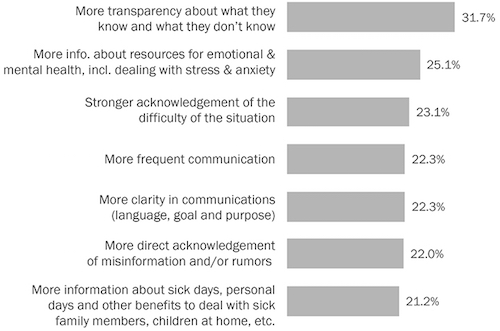Most companies seem to understand the importance of communicating with employees during the COVID-19 pandemic, but a discrepancy exists between what information employees want to hear and what they’re actually being told, according to a study by communications agency Orangefiery.
The Orangefiery survey, which sought to gauge what qualities employees and companies look for in COVID-19-based outreach, found that workers and business leaders appear to differ in regards to what content and strategies make for effective COVID-19-based communication.
A majority of those surveyed characterized the pandemic-related communications they’ve received from companies as trustworthy (66 percent), appropriate in tone (66 percent), clear (64 percent) and honest and open (63 percent). And overall, more than half of respondents (55 percent) said they’re satisfied with the messages they’ve received from business leaders, with 53 percent claiming those messages have been very or extremely useful in communicating what employees should think or do in light of the pandemic.
But the survey also discovered a sizeable gap between company and employee opinions regarding the preferred content and perceived effectiveness of COVID-19-based communication.
The private sector, for its part, believes it’s been delivering on-topic messaging (82 percent) through the appropriate communications channels (85 percent) and at an appropriate frequency (79 percent). In terms of topics addressed, most respondents reported that the messaging they’ve seen has focused largely on recommendations for preventing the spread of COVID-19, the pandemic’s impact on the organization and public health orders’ impact on business operations.
 What messages people want to see more from in regards to the private sector’s COVID-19 communication. What messages people want to see more from in regards to the private sector’s COVID-19 communication. |
On the other hand, about a third of employees (32 percent) said they’d prefer it if their place of employment was more transparent regarding what it knows and what it doesn’t. A quarter of employees (25 percent) also said they want access to information regarding resources for emotional and mental health, including dealing with stress and anxiety. An additional 22 percent said they also wanted frequent and clear communications.
Naturally, company leaders were typically more likely to give higher marks to the private sector’s overall handling of COVID-19-related communications than employees.
While nearly two-thirds (64 percent) of business leaders consider their organization to be extremely or very committed to satisfying employees’ communications needs, only 54 percent of employees believe this. More than half (60 percent) of business leaders said their organization is very or extremely interested in hearing employee feedback during this pandemic, while only 43 percent of employees agree.
Business leaders were also more likely than employees to claim that private sector communications have been very or extremely trustworthy (75 percent vs. 63 percent), clear (69 percent vs. 62 percent), honest and open (75 percent vs. 58 percent), successful at alleviating anxiety and concern (46 percent vs. 33 percent) and useful at communicating what employees should think and do (58 percent vs. 51 percent).
Orangefiery’s study surveyed 454 U.S. adults who identified as either employees or company leaders (board members, executive team members or management team members) between March 25 and March 29.


 There’s a fine line between newsjacking and taking advantage, aka ambulance chasing. Our job as PR professionals is to tread it carefully.
There’s a fine line between newsjacking and taking advantage, aka ambulance chasing. Our job as PR professionals is to tread it carefully. PR firms need to be mindful of ways their work product may be protected by the attorney-client privilege whenever working with a client’s internal legal team or its external legal counsel.
PR firms need to be mindful of ways their work product may be protected by the attorney-client privilege whenever working with a client’s internal legal team or its external legal counsel. Manuel Rocha, former US ambassador and intenational business advisor to LLYC, plans to plead guilty to charges that he was a secret agent for Cuba.
Manuel Rocha, former US ambassador and intenational business advisor to LLYC, plans to plead guilty to charges that he was a secret agent for Cuba. CEO mentoring is an often-overlooked aspect of why CEOs are able to make good decisions, and sometimes make bad ones—all of which intersects with the role and duties of a board.
CEO mentoring is an often-overlooked aspect of why CEOs are able to make good decisions, and sometimes make bad ones—all of which intersects with the role and duties of a board.  How organizations can anticipate, prepare and respond to crises in an increasingly complex world where a convergent landscape of global challenges, threats and risks seem to arrive at an unrelenting pace.
How organizations can anticipate, prepare and respond to crises in an increasingly complex world where a convergent landscape of global challenges, threats and risks seem to arrive at an unrelenting pace.


 Have a comment? Send it to
Have a comment? Send it to 
No comments have been submitted for this story yet.